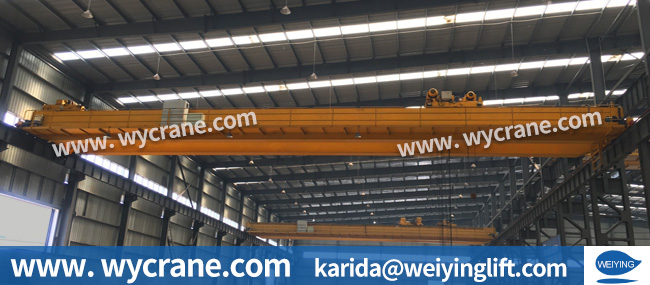The double-girder overhead crane is engineered around two parallel steel girders, which form the backbone of its load-bearing capacity. These girders are precision-fabricated using Q345B-grade steel (yield strength ≥345 MPa), selected for its optimal balance of ductility and rigidity. Depending on operational requirements, engineers opt for two distinct cross-sectional profiles:
Box-Type Girder: Constructed from welded steel plates forming a hollow rectangular section. This design excels in torsional resistance (withstand up to 12,000 N·m/㎡ stress) and uniform load distribution, making it ideal for applications involving asymmetric loads, such as lifting irregularly shaped machinery.
H-Type Girder: Features an I-beam profile created by rolling or welding steel plates. While offering 18–22% weight reduction compared to box girders, it maintains 85% of the bending strength, suitable for installations where minimizing structural weight is prioritized, such as retrofitting older factories with lower roof load ratings.
The bridge frame, connecting both girders, incorporates a three-stage power transmission system:
Primary drive motors (typically 4–8 poles, 15–400 kW output)
Helical gear reducers (transmission ratios 1:12 to 1:200)
Spring-applied, electrically released brakes (response time <0.3 seconds)
This configuration achieves 92–95% mechanical efficiency while maintaining a compact footprint.
Vertical Lifting System
Utilizes a grooved drum (diameter 400–2,000 mm) wound with 6–36 mm diameter steel wire ropes (breaking load 1,570–2,160 MPa).
Speed ranges from 1.5 m/min (for micro-positioning fragile glass panels) to 38 m/min (bulk material handling in foundries), controlled via encoder feedback to PLCs (positioning accuracy ±2 mm).
Safety factor of 5:1 for wire ropes, exceeding ISO 4308-1 standards.
Longitudinal Travel Mechanism
Driven by flanged wheels (diameter 250–800 mm) running on DIN 536-1 standard rails (QU80–QU120 profiles).
Travel speeds adapt to span lengths:
4–10 m spans: 4–20 m/min (precision workshops)
20–35 m spans: 30–72 m/min (large storage yards)
Anti-derailment flanges maintain ≤3 mm wheel-to-rail clearance.
Cross Travel System
Trolley employs V-groove wheels (polyurethane-coated for noise reduction ≤75 dB(A)) on hardened steel tracks.
Lateral positioning accuracy of ±1.5 mm achieved through servo-controlled motion profiles.

Dynamic Load Compensation:
Finite Element Analysis (FEA)-optimized girder designs reduce mid-span deflection to ≤1/800 of span length under full load (e.g., 10 mm deflection on 8 m span with 100-ton load).
Modular Connection System:
High-strength bolted joints (10.9-grade M24–M36 bolts) enable rapid assembly/disassembly, reducing installation time by 40% compared to welded structures.
Adaptive Frequency Conversion:
4-quadrant AC drives regenerate braking energy (up to 25% energy recovery in frequent start/stop operations).
S-curve acceleration algorithms eliminate mechanical shock (jerk limited to 0.8 m/s³).
Anti-Sway Technology:
Combines inertial measurement units (IMU) to detect load oscillation.
PID-controlled trolley movements dampen swing within 3–5 cycles (final residual sway angle <0.25°).
Engine Assembly Lines:
12-ton capacity cranes position V8 engines (tolerance ±0.5 mm) onto chassis.
Low-voltage controls (24V DC) prevent electromagnetic interference with robotic welders.
Press Shop Operations:
50-ton foundry cranes handle 5×3×2 m die sets using spreader beams with automatic tilt correction.
Container Transshipment:
60-ton cranes with 35 m span transfer ISO containers between vessels and yard stacks.
GPS-guided travel systems synchronize with terminal operating software (TOS), achieving 35 moves/hour.
Cold Chain Facilities:
Stainless steel construction cranes operate in -30°C environments, featuring heated bearing housings and cold-resistant lubricants.
Steelmaking:
450-ton ladle cranes with 2.5 m/min creep speed pour molten steel into continuous casters.
Thermal barriers protect electrical components from 80°C ambient temperatures.
Power Generation:
Turbine hall cranes install 300-ton rotors using dual-hoist synchronization (load distribution accuracy ±1%).
Seismic-rated designs withstand 0.3g horizontal accelerations (IBC 2018 Class III).

Energy Efficiency:
Regenerative drives reduce power consumption by 18–22% in duty cycles with >30 starts/hour.
LED runway lights (50W vs traditional 400W sodium lamps) cut lighting energy use by 87%.
Maintenance Economics:
Sealed-for-life gearboxes (50,000-hour MTBF) eliminate lubrication downtime.
Online monitoring systems predict bearing failures 300–500 hours in advance.
Automotive Sector:
22% reduction in engine installation time (from 45 to 35 minutes/unit).
0.012% defect rate in precision lifts (vs 0.15% with manual handling).
Steel Plants:
Ladle transfer cycle time reduced from 8 to 5.5 minutes, increasing daily output by 15%.
EN 13001-1:2018 (Crane design principles)
FEM 1.001:2020 (Testing and acceptance criteria)
ISO 23814:2022 (Anti-corrosion requirements)
Load Monitoring:
Strain-gauge sensors with 0.5% F.S. accuracy monitor real-time load distribution.
Automatic shutdown triggers at 105% rated capacity.
Emergency Stop:
Dual-channel braking: regenerative electrical brake + mechanical disc brake (deceleration ≥1.5 m/s²).
Battery-backed UPS maintains control power for 30-minute safe load lowering.

Through systematic integration of mechanical robustness and advanced automation, the double-girder overhead crane addresses contemporary industrial challenges across sectors. Its technical specifications—from 800-ton lifting capacity to sub-millimeter positioning—coupled with energy-efficient operation and predictive maintenance capabilities, establish it as a cornerstone technology in heavy material handling. The design’s adaptability to extreme environments (-40°C to +50°C operational range) and compliance with global safety standards further solidify its role in modern industrial infrastructure.
For more information, feel free to contact us! We’re happy to provide advice and tailored solutions!
We have 34 years of manufacturing experience and 12 years of export experience,business covers over 100 countries and regions worldwide, including Asia, Europe, America, Africa, and Oceania, forming a global product sales network.Received ISO system certification and CE product certification!
Our main products include 6 series of nearly 100 varieties, including electric hoists, electric winches, gantry cranes, bridge cranes, marine cranes, and gantry cranes.
E-mail: karida@weiyinglift.com
Website: www.wycrane.com